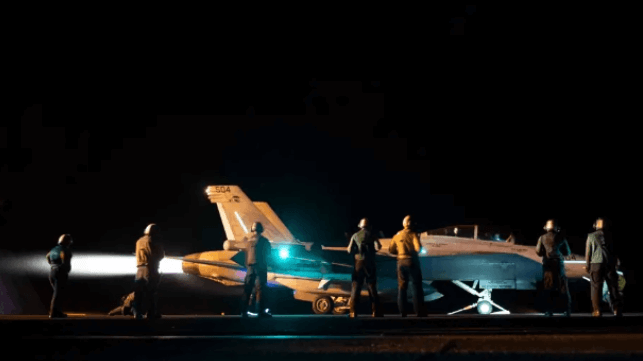U.S. Carrier Held Back in Fight With Houthis to Avoid Angering Iran

The U.S. Navy's Carrier Strike Group Two was instructed to limit large-scale counterstrikes against Houthi rebels in order to avoid upsetting the delicate balance of deterrence with Iran, the CSG's former commander suggested in an interview released Monday.
Rear Adm. Marc Miguez was the commander of the strike group when it made its historic deployment to the Red Sea in November 2023. He served until June 16, when he was relieved and dispatched to Washington, D.C. to run the Navy's legislative affairs office.
USS Dwight D. Eisenhower was in the thick of the counter-Houthi operation from the start, and at its peak, the carrier was launching fighters to up to nine events a day. Its pilots put in more than 30,000 flight hours and launched more than 60 air-to-air missiles. The destroyer escorts used up so many missiles that they had to set up a pierside resupply operation in nearby Yanbu, Saudi Arabia. It was all within the crew's training, Miguez told former Navy commander and Youtuber Ward Carroll - except for the unexpected volume of Houthi unmanned aerial vehicles.
"Just the immense number of UAV interactions that we had, that was something that we did not holistically train to . . . not on the level that we had to encounter in combat," he said.
Just protecting USS Eisenhower from attack was a significant endeavor. The carrier had at least two fighters up and nearby at all times to carry out air defense. If it couldn't have its own fighters in the air, it drew on the resources of the U.S. Air Force, which would dispatch land-based planes to fly an equivalent force-protection mission around the carrier.
Initially, Eisenhower had freedom of movement within the operating area, but as time went on and Houthi attacks became more sophisticated, Miguez had to reposition in order to make the carrier a harder target. "For force protection, I had to move the carrier multiple times," he said.
Eisenhower's crew got to hit back at the Houthi threat with seven large coordinated strikes, working with the Air Force and with allied partners. "We were definitely degrading their capability," Miguez said. But the task force was not permitted to bring is full might to bear against all targets.

that matters most
Get the latest maritime news delivered to your inbox daily.
"There are definite strategies that were put forward, but our National Command Authority decided that those - I would call more aggressive postures and more aggressive strikes - was not something we wanted to challenge," Miguez said. "We all know Iranian-backed groups like the Houthis, where that threat's emanating from . . . And so that is the calculus that's handled at echelon zero, at the National Command Authority, with NSA, and everybody else. Those are things that I don't dabble in."
Going forward, Miguez suggested that diplomacy and economic pressure will be required to restore maritime security in the Red Sea, along with more aggressive military action. "This is a whole-of-government approach," he said. "I think that's what is going to result in freedom of navigation in that critical strait."
